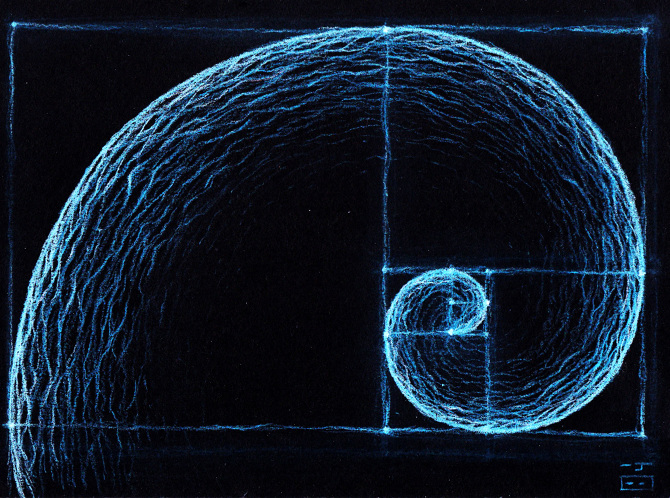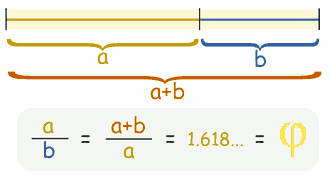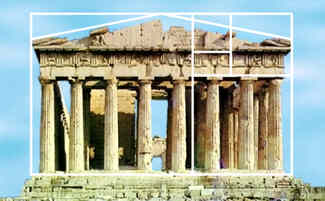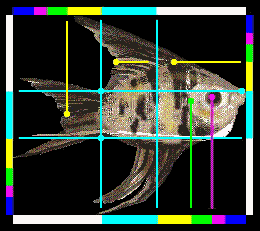The Golden Mean - Golden Ratio - Fibonacci
Golden Ratio

 |
The golden ratio (symbol is the Greek
letter "phi" shown at left) is a special number approximately equal 1.618
It appears many times in geometry, art,
architecture and other areas.
The Golden ratio is a special number found by
dividing a line into two parts so that the longer part divided by the smaller part is also equal to the whole length divided by the longer part. It is often symbolized using phi, after the 21st letter of the Greek alphabet. In an equation form, it looks like this
a/b = (a+b)/a = 1.6180339887498948420 …
We find the golden ratio when we divide
line into two parts so that:

As with pi (the ratio of the circumference of
a circle to its diameter), the digits go on and on, theoretically into infinity. Phi is usually rounded off to 1.618. This number has been discovered and rediscovered many times, which is why it has so many names — the Golden mean, the Golden section, divine proportion, etc. Historically, the number can be seen in the architecture of many ancient creations, like the Great Pyramids and the Parthenon. In the Great Pyramid of Giza, the length of each side of the base is 756 feet with a height of 481 feet. The ratio of the base to the height is roughly 1.5717, which is close to the Golden ratio.
Around 1200, mathematician Leonardo Fibonacci discovered the
unique properties of the Fibonacci sequence. This sequence ties directly into the Golden ratio because if you take any two successive Fibonacci numbers, their ratio is very close to the Golden ratio. As the numbers get higher, the ratio becomes even closer to 1.618. For example, the ratio of 3 to 5 is 1.666. Getting even higher, the ratio of 144 to 233 is 1.618. But the ratio of 13 to 21 is 1.625. These numbers are all successive numbers in the Fibonacci sequence.
Many buildings and artworks have
the Golden Ratio in them, such as the Parthenon in Greece, but it is not really known if it was designed that way. 
These numbers can be applied to the
proportions of a rectangle, called the Golden rectangle. This is known as one of the most visually satisfying of all geometric forms – hence, the appearance of the Golden ratio in art. The Golden rectangle is also related to the Golden spiral, which is created by making adjacent squares of Fibonacci dimensions.
In 1509, Luca Pacioli wrote a book that
refers to the number as the
"Divine Proportion,"
which was illustrated by Leonardo da Vinci. Da Vinci later called this sectio aurea or the Golden section. The Golden ratio was used to achieve balance and beauty in many Renaissance paintings and sculptures. Da Vinci himself used the Golden ratio to define all of the proportions in his Last Supper, including the dimensions of the table and the proportions of the walls and backgrounds. The Golden ratio also appears in da Vinci's Vitruvian Man and the Mona Lisa. Other artists who employed the Golden ratio include Michelangelo, Raphael, Rembrandt, Seurat, and Salvador Dali. 
Flower petals: The number of petals on
some flowers follows the Fibonacci sequence. It is believed that in the Darwinian processes, each petal is placed to allow for the best possible exposure to sunlight and other factors. 
Seed heads: The seeds of a flower are
often produced at the center and migrate outward to fill the space. For example, sunflowers follow this pattern. 
Pinecones: The spiral pattern of the seed
pods spiral upward in opposite directions. The number of steps the spirals take tend to match Fibonacci numbers. 
Tree branches: The way tree branches form
or split is an example of the Fibonacci sequence. Root systems and algae exhibit this formation pattern. 
Shells: Many shells, including snail shells and nautilus shells, are perfect
examples of the Golden spiral. 
Spiral galaxies: The Milky Way has a number of spiral arms, each of which
has a logarithmic spiral of roughly 12 degrees. The shape of the spiral is identical to the Golden spiral, and the Golden rectangle can be drawn over any spiral galaxy. 
Hurricanes: Much like shells, hurricanes often display the Golden spiral.

Fingers: The length of our fingers, each section from the tip of the base to
the wrist is larger than the preceding one by roughly the ratio of phi. 
Animal bodies: The measurement of the human navel to the floor and the top
of the head to the navel is the Golden ratio. But we are not the only examples of the Golden ratio in the animal kingdom; dolphins, starfish, sand dollars, sea urchins, ants and honeybees also exhibit the proportion.  
DNA molecules: A DNA molecule measures 34 angstroms by 21 angstroms
at each full cycle of the double helix spiral. In the Fibonacci series, 34 and 21 are successive numbers. 
NOW HERE IS AN GOLDEN MEAN
IN SOME OF OUR MOST POPULAR BRANDS ....    if you enjoyed this blog on "The Golden Ratio" please read my blog about "Holograms" HOLOGRAMS : HOW DO THEY WORK this is the link. enjoy |







Comments
Post a Comment